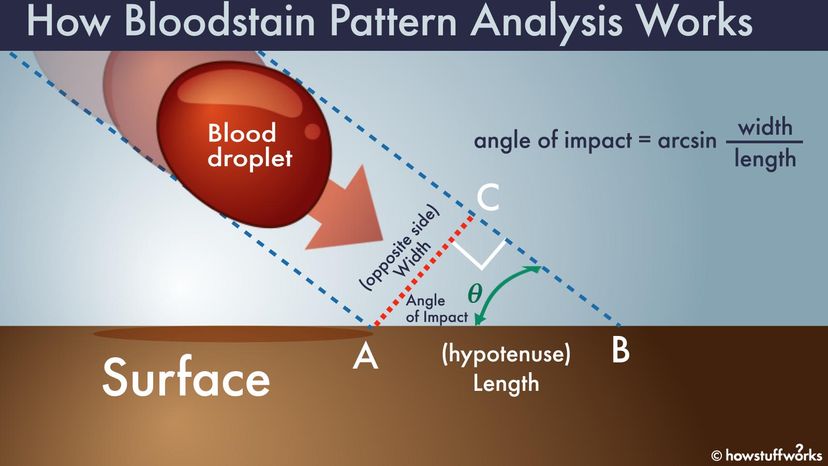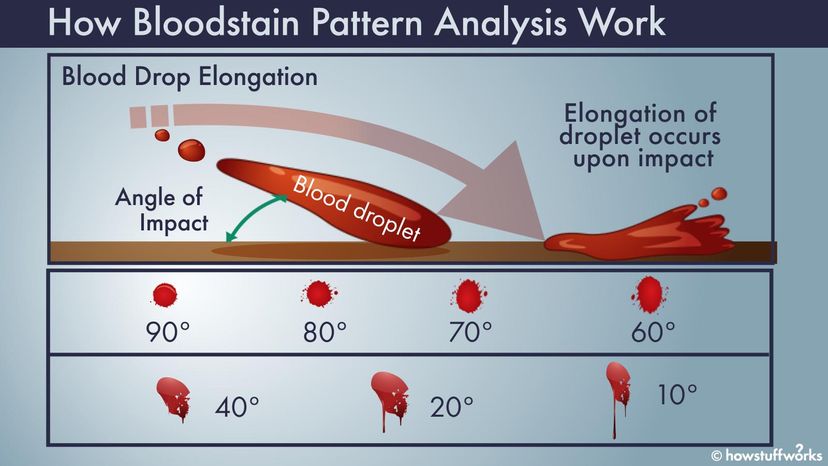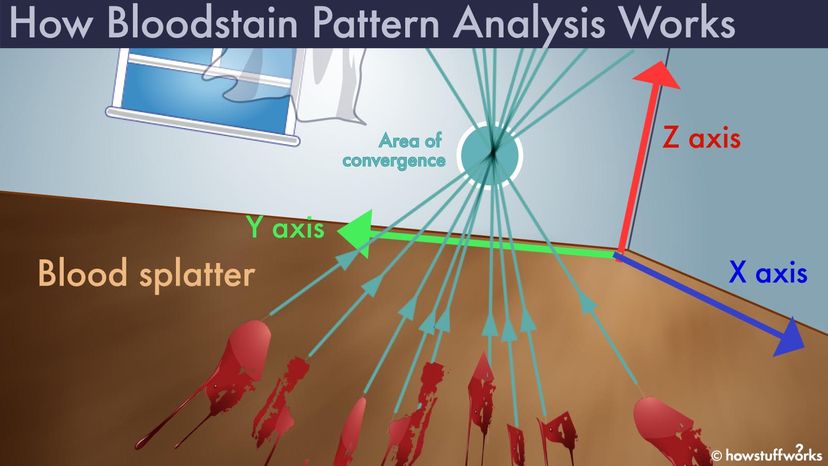Stringing, Sine and Spatter Shapes

To analyze a bloodstain pattern, an expert relies on three main interrelated elements: the size, shape and distribution of bloodstains. Since we've already discussed stain size, let's dive right into shape. Blood drops that fall straight down, with little but gravity and air resistance affecting them, make round stains. Blood moving at an angle and sped along by some force, however, tends to make elongated marks, especially when it strikes a nonporous surface.
As a rule, following the long axis of the stain from the blunter end to the sharper, more disturbed edge reveals the direction the blood traveled. If a number of stains radiate outward, analysts can draw lines backward along these axes to an area of convergence. But this gives them an area in only two dimensions. Investigators must also determine the blood's impact angle [source: Dutelle].
Advertisement
The lower the angle at which blood strikes a surface, the thinner and more elongated the stain. The converse holds true as well. For example, if a blood droplet has a 10-degree drop, it creates a highly elongated stain, whereas a droplet with a 90-degree (vertical) drop leaves a round stain [source: Dutelle]. Measuring a stain's width and length, analysts use the following mathematical formula to calculate the impact angle:

The greater the difference between the width and length, the sharper the angle of impact [source: Dutelle]. For example, imagine a bloodstain 0.08 inches wide by 0.16 inches long (2 by 4 millimeters). The width divided by the length equals 0.5. The ArcSin of 0.5 is 30, meaning the blood hit the surface at a 30-degree angle. In a bloodstain measuring 0.04 by 0.16 inches (1 by 4 millimeters), the impact angle comes out to about 14.5 degrees.
If the bloodstain has a tail, as can occur in droplets striking a surface at certain angles and speeds, it should be left out of this calculation [sources: Dutelle, Eckert and James].
Once analysts know all three angles, they can move on to the most visually striking part of the process, and therefore the one most featured in shows like "Dexter" — the technique of stringing. Stringing involves running strings from the rear edges of the bloodstains upward at the appropriate angles to find where they roughly meet — the area of origin. This technique provides only an approximation, however, and is mainly used to establish whether a victim was seated, standing or lying down when the event occurred. The presence or absence of blood on other surfaces, combined with common sense, also aids in this analysis [source: Dutelle].
Increasingly, analysts are taking advantage of computer programs that allow them to store spatter data, calculate values such as impact angle, and display information in helpful 3D renderings. Initially, this software required manual data entry, which was tedious but perhaps not as tedious as stringing.

Developers are working on software that can automatically reconstruct a single coordinate frame from several images, limiting user input. Others are working on using laser scanning and even machine learning to analyze the blood spatter.
So far, we've discussed how bloodstain pattern analysis can work when trained law enforcement officers implement it correctly. Next, we'll look at the history of bloodstain pattern analysis, as well as an infamous case that contains botched bloodstain pattern analysis practices.